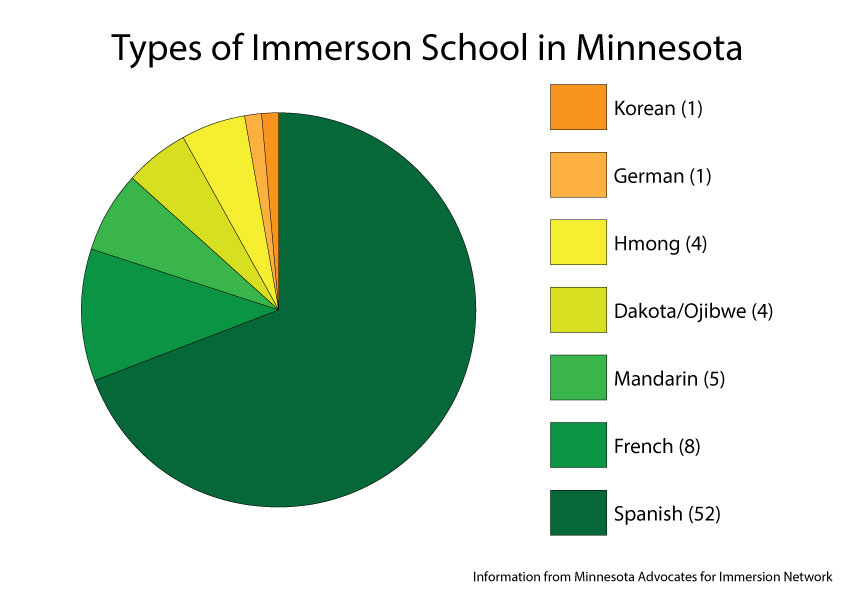Immersion schools give students “a step up”
This infographic shows the types of immersion schools across the state of Minnesota. There are 52 Spanish immersion schools, 8 French, 5 Mandarin, 4 Dakota/Ojibwe, 4 Hmong, 1 German, and 1 Korean. There are a total of 75 immersion schools in Minnesota. Infographic: Eli Shimanski
February 9, 2018
Immersion schools seem to give students a step up with both language classes and in the broader world: both professionally and socially. Although it’s sometimes hard for immersion students students to adjust to the more “typical” American teaching of foreign language (which is mostly through breaking down grammar and listening) and for teachers to teach in a way that works for the student, the benefits of going to a school that teaches you a language at such a young age are usually overwhelming.
According to HudsonWay Immersion School website, almost all immersion preschool classes are in the chosen language, slowly adding more and more English until the classes are about 40% in English. According the Anwatin Middle School website in Minneapolis, the science, social studies, and advanced Spanish classes take place in Spanish whereas the rest of the classes, like English and Math are taught in English with the rest of the school.
Sheila Willette, a Spanish three and five teacher at South explained the struggle of placing students when they come from an immersion school to high school. “It’s hard to place students [level wise]… it’s really challenging for Spanish because students have been exposed to Spanish anywhere from kindergarten, to sixth grade, to not at all. It’s always hard to place students. It’s usually a bit easier within the Minneapolis Public Schools, because we have a formula…. we can calculate where they belong… but we don’t have a streamline path for immersion students.”
Stacia Schirber, a sophomore, who attended Emerson Elementary and Anwatin Middle School, both immersion schools in Minneapolis, explained that her parents chose to go the immersion path because, “[they] wanted me to have more opportunities with jobs and to “immerse” me and give me a step up.”
Olivia Sather, a freshman who also attended both Emerson and Anwatin explained, “[My parents] are fluent in Spanish… we also have some close neighbors who are from Colombia so we’ve kind of grown up around Spanish and I think they both thought it was important for me and my brother to learn.”
Schirber and Sather explained that they really found no drawbacks in immersion school, both said that it has helped them a lot with dedication and persistence. Sather said, “I think that it gave me more opportunity to know more people, study abroad, or find a career where I use Spanish a lot.”
Ian Zibble, a sophomore, attended the Twin Cities German Immersion School for 9 years. Zibble said, “my great grandpa came from some German speaking country and most of my family on my dad’s side speak German and they wanted me to be able to too.” He believes that other than the language, he really didn’t learn much different from what he believes is the classic school curriculum.
Zibble, who went to a school of about 200 people explained that he felt he missed out on major social aspects at such a small immersion school. “It was a ridiculously small school so I feel like I was socially sheltered. Social interactions are hard for me because I grew up with the same people all the time. It was basically like a family, or having a best friend with you all the time, but that was the only social interaction we had. It definitely made me more socially underdeveloped.”
Zibble feels like the experience was definitely worth it, he feels like a lot of opportunities opened up for him. “I think it’s gonna open up a lot of doors for me, because I’m completely fluent in the language so I can put that on resumes… In our immersion school, we took a test and if we pass it we have the opportunity to go to a German college for free so I’m probably going to end up going to Germany for a few years to get my bachelors degree.”
“I feel like a lot of people by the end of middle school were like ‘I hate immersion school, it’s boring, I don’t want to learn Spanish anymore’ and they would not speak Spanish in class,” Sather explained, “I just thought it was so dumb because there is a huge opportunity that you have that so many people don’t get that chance to learn it the way we learned it which was so much more organic and it’s more fun to learn that way. It sticks in your head more.” Schirber said, “I thank my parents all the time for putting me in immersion school because it has helped a lot.”






